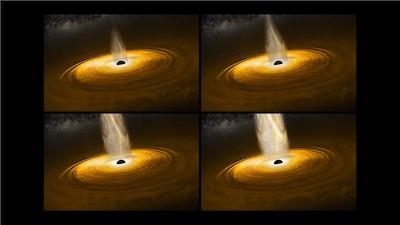Uses Echoes From Radiation To Map Regions Around The Phenomena
Material falling into a black hole casts X-rays out into space – and now, for the first time, ESA’s XMM-Newton X-ray observatory has used the reverberating echoes of this radiation to map the dynamic behavior and surroundings of a black hole itself.

Most black holes are too small on the sky for us to resolve their immediate environment, but we can still explore these mysterious objects by watching how matter behaves as it nears, and falls into, them. As material spirals towards a black hole, it is heated up and emits X-rays that, in turn, echo and reverberate as they interact with nearby gas. These regions of space are highly distorted and warped due to the extreme nature and crushingly strong gravity of the black hole.
For the first time, researchers have used XMM-Newton to track these light echoes and map the surroundings of the black hole at the core of an active galaxy. Named IRAS 13224–3809, the black hole’s host galaxy is one of the most variable X-ray sources in the sky, undergoing very large and rapid fluctuations in brightness of a factor of 50 in mere hours.
“Everyone is familiar with how the echo of their voice sounds different when speaking in a classroom compared to a cathedral – this is simply due to the geometry and materials of the rooms, which causes sound to behave and bounce around differently,” explains William Alston of the University of Cambridge, UK, lead author of the new study.
“In a similar manner, we can watch how echoes of X-ray radiation propagate in the vicinity of a black hole in order to map out the geometry of a region and the state of a clump of matter before it disappears into the singularity. It’s a bit like cosmic echo-location.”
As the dynamics of infalling gas are strongly linked to the properties of the consuming black hole, William and colleagues were also able to determine the mass and spin of the galaxy’s central black hole by observing the properties of matter as it spiralled inwards. The inspiralling material forms a disc as it falls into the black hole. Above this disc lies a region of very hot electrons – with temperatures of around a billion degrees – called the corona. While the scientists expected to see the reverberation echoes they used to map the region’s geometry, they also spotted something unexpected: the corona itself changed in size incredibly quickly, over a matter of days. “As the corona’s size changes, so does the light echo – a bit like if the cathedral ceiling is moving up and down, changing how the echo of your voice sounds,” William said.
“By tracking the light echoes, we were able to track this changing corona, and – what’s even more exciting – get much better values for the black hole’s mass and spin than we could have determined if the corona was not changing in size. We know the black hole's mass cannot be fluctuating, so any changes in the echo must be down to the gaseous environment.”
The study used the longest observation of an accreting black hole ever taken with XMM-Newton, collected over 16 spacecraft orbits in 2011 and 2016 and totalling 2 million seconds – just over 23 days. This, combined with the strong and short-term variability of the black hole itself, allowed William and collaborators to model the echoes comprehensively over day-long timescales.
The region explored in this study is not accessible to observatories such as the Event Horizon Telescope, which managed to take the first ever picture of gas in the immediate vicinity of a black hole – the one sitting at the centre of the nearby massive galaxy M87. The result, based on observations performed with radio telescopes across the world in 2017 and published last year, immediately became a global sensation. “The Event Horizon Telescope image was obtained using a method known as interferometry – a wonderful technique that can only work on the very few nearest supermassive black holes to Earth, such as those in M87 and in our home galaxy, the Milky Way, because their apparent size on the sky is large enough for this method to work,” says co-author Michael Parker, who is an ESA research fellow at the European Space Astronomy Centre near Madrid, Spain.
“By contrast, our approach is able to probe the nearest few hundred supermassive black holes that are actively consuming matter – and this number will increase significantly with the launch of ESA’s Athena satellite.”
Characterizing the environments closely surrounding black holes is a core science goal for ESA’s Athena mission, which is scheduled for launch in the early 2030s and will unveil the secrets of the hot and energetic Universe. Measuring the mass, spin and accretion rates of a large sample of black holes is key to understanding gravity throughout the cosmos. Additionally, since supermassive black holes are strongly linked to their host galaxy’s properties, these studies are also key to furthering our knowledge of how galaxies form and evolve over time.
“The large dataset provided by XMM-Newton was essential for this result,” says Norbert Schartel, ESA XMM-Newton Project Scientist. “Reverberation mapping is an exciting technique that promises to reveal much about both black holes and the wider Universe in coming years. I hope that XMM-Newton will perform similar observing campaigns for several more active galaxies in coming years, so that the method is fully established when Athena launches.”
(Image provided with ESA news release)
 Airborne 10.14.25: Laser Threat, VeriJet BK, Duffy Threatens Problem Controllers
Airborne 10.14.25: Laser Threat, VeriJet BK, Duffy Threatens Problem Controllers Airborne 10.15.25: Phantom 3500 Confounds, Citation CJ3 Gen2 TC, True Blue Power
Airborne 10.15.25: Phantom 3500 Confounds, Citation CJ3 Gen2 TC, True Blue Power Aero-News: Quote of the Day (10.17.25)
Aero-News: Quote of the Day (10.17.25) NTSB Prelim: Piper PA-28-180
NTSB Prelim: Piper PA-28-180 ANN FAQ: Contributing To Aero-TV
ANN FAQ: Contributing To Aero-TV



